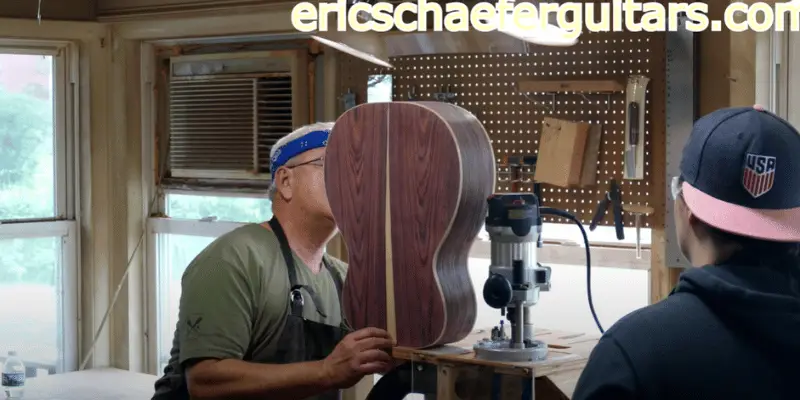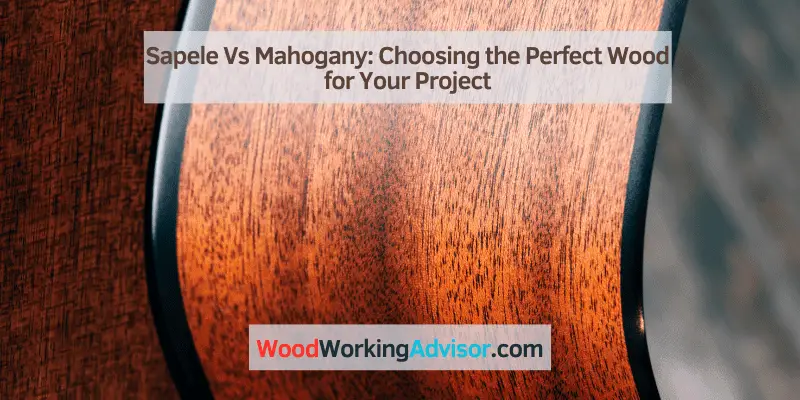Sapele and mahogany are both tropical hardwoods known for their rich colors and durability. Sapele is an African wood with a reddish-brown hue and interlocking grain, while mahogany is a versatile hardwood with a deep reddish-brown color and straight grain pattern.
Both woods are commonly used in furniture making, cabinetry, and musical instruments due to their strength and stability. However, sapele is often preferred for its affordability and similarity in appearance to mahogany, making it a popular alternative for budget-conscious projects.
Understanding the characteristics and differences between these two woods can help you make an informed decision when selecting the right material for your woodworking or construction project. By weighing the unique qualities of sapele and mahogany, you can choose the best option that meets your specific needs and preferences.
Understanding Sapele And Mahogany
Sapele and Mahogany are two popular choices for woodworking and furniture making due to their desirable characteristics and rich aesthetics. Understanding the differences and similarities between these two hardwoods can help you make informed decisions when choosing the right material for your project.
Similarities And Differences
Both Sapele and Mahogany belong to the same family of trees, and they are known for their stability, strength, and beautiful grain patterns. However, there are some key differences that set them apart. Sapele is often considered a more affordable alternative to Mahogany, making it an attractive option for those on a budget. On the other hand, Mahogany is renowned for its classic beauty and timeless appeal, making it a preferred choice for high-end furniture and cabinetry.
Grain Patterns And Color
When it comes to the grain patterns and color, Sapele boasts a distinctive interlocking grain that creates a stunning ribbon-stripe effect when quarter-sawn. Its color ranges from reddish-brown to deep red, adding warmth and depth to any piece. In contrast, Mahogany exhibits a straight, fine, and uniform grain with a rich, reddish-brown hue that darkens over time, giving it a luxurious patina.
Durability And Workability
In terms of durability, both Sapele and Mahogany are highly resistant to rot, decay, and insect infestation, making them ideal choices for outdoor and marine applications. However, Sapele tends to be slightly harder and denser than Mahogany, offering excellent stability and machinability. Mahogany, on the other hand, is known for its superb workability, allowing for smooth cutting and shaping with minimal tear-out.

Applications In Woodworking Projects
When it comes to woodworking projects, choosing the right type of wood is crucial to ensure the durability, aesthetic appeal, and functionality of the finished product. Two popular choices often compared in woodworking are Sapele and Mahogany, both known for their distinctive qualities and versatility in various applications. Let’s delve into how these woods are utilized in specific woodworking projects.
Furniture Making
Furniture making relies heavily on the quality and characteristics of the wood selected. Sapele wood’s interlocking grain and beautiful reddish-brown color make it an excellent choice for crafting high-quality furniture pieces. Its remarkable stability, resistance to warping, and ease of finishing make it a preferred option for creating durable and visually appealing furniture pieces.
Cabinetry And Millwork
In cabinetry and millwork, Mahogany stands out for its fine texture, straight grains, and rich reddish-brown color. Its exceptional workability, resistance to rot and decay, as well as its ability to take stains and finishes well, make it a popular choice for crafting sophisticated cabinetry and millwork projects. The luxurious appearance and durability of Mahogany often make it the wood of choice for high-end cabinetry and millwork.
Musical Instruments
When it comes to crafting musical instruments, Sapele and Mahogany are both highly regarded for their tonal qualities and structural integrity. Sapele, with its fantastic resonance and tonal warmth, is frequently used in the construction of acoustic guitars and other stringed instruments. On the other hand, Mahogany’s density and rich, warm sound make it a preferred material for constructing guitar necks, backs, and sides, as well as other musical instrument components.
Cost And Availability
When it comes to selecting wood for a project, understanding the cost and availability of materials is crucial. Sapele and Mahogany are two popular choices known for their beauty and durability. Let’s delve into the market pricing, sourcing and sustainability, and the impact on project budget for these two stunning wood options.
Market Pricing
Both Sapele and Mahogany are considered premium hardwoods, and as such, they typically come with a higher price tag compared to softer woods. Mahogany is often known to be on the pricier side due to its reputation for being a luxury wood used in high-quality furniture and cabinetry. Sapele, on the other hand, is slightly more affordable, making it an attractive alternative for those with budget constraints.
Sourcing And Sustainability
When sourcing wood, it’s essential to consider sustainability. Mahogany, particularly genuine mahogany, comes with concerns regarding deforestation and illegal logging. On the other hand, Sapele is known for being more sustainably sourced, making it an environmentally conscious choice for those seeking eco-friendly materials.
Impact On Project Budget
The choice between Sapele and Mahogany can significantly impact your project budget. While both woods offer exceptional quality and aesthetic appeal, the pricing difference between the two can have a notable impact on the overall cost of your project. It’s essential to weigh the pros and cons of each wood species to ensure your project aligns with your budgetary requirements while still maintaining the desired level of quality and beauty.
Finishing And Maintenance Considerations
When it comes to choosing between sapele and mahogany for your woodworking project, it’s crucial to consider the finishing and maintenance requirements of each wood type. Understanding how these woods respond to stains, finishing techniques, long-term care, and aging is essential in making a well-informed decision. Let’s delve into the specifics of finishing and maintenance considerations for sapele and mahogany.
Staining And Finishing Techniques
Both sapele and mahogany respond well to a variety of staining and finishing techniques, allowing for versatility in achieving desired appearances. However, due to its interlocking grain, sapele may require a pre-conditioning step to ensure an even stain application. On the other hand, mahogany’s straight grain makes it more forgiving when staining straight from the can.
Long-term Care And Maintenance
When it comes to long-term care and maintenance, both sapele and mahogany are relatively low-maintenance options. Regular dusting and occasional polishing are often sufficient to keep their luster intact. However, sapele may require more frequent maintenance due to its susceptibility to scratches and dents compared to the denser mahogany.
Comparing Aging And Patina
As these woods mature, their aging characteristics and patina differ. Sapele tends to darken and develop a rich reddish-brown hue over time, while mahogany slowly deepens into a deep, reddish-brown patina, enhancing its natural beauty. The choice between the two boils down to the desired aging and patina effects for your project.
Conclusion: Making The Best Choice For Your Project
When choosing between Sapele and Mahogany for your project, it’s essential to consider the unique characteristics of each wood. Sapele offers a rich, reddish-brown hue and exceptional durability, while Mahogany boasts a warm, reddish-brown color and excellent workability. Understanding these differences will enable you to make the best choice for your specific project needs.
Factors To Consider
Sapele and Mahogany are both popular wood choices for various projects, each with its own unique properties and characteristics. When considering which wood to use for your project, several key factors should be taken into account.
- Cost: Consider the budget for your project and choose the wood that best aligns with your financial considerations.
- Durability: Evaluate the durability and resistance to wear and tear required for the specific application of the wood.
- Availability: Check the availability of the wood species in your local area or through suppliers, as this can impact the overall project timeline.
- Workability: Assess the ease of working with the wood for your specific project requirements, considering factors such as cutting, shaping, and finishing.
Final Selection Based On Project Requirements
Ultimately, the choice between Sapele and Mahogany should be based on how well each wood aligns with the specific requirements of your project. Consider the structural needs, environmental factors, and overall design goals when making the final decision.
Achieving The Desired Aesthetic And Functional Outcomes
Both Sapele and Mahogany offer distinct visual and functional benefits. Consider the appearance, grain pattern, and color of each wood species in relation to the aesthetic goals of your project. Additionally, take into account the specific functional properties required for the intended use of the wood.
Frequently Asked Questions On Sapele Vs Mahogany
What Are The Main Differences Between Sapele And Mahogany Wood?
Sapele and Mahogany wood differ in terms of color, grain pattern, and workability. Sapele has a darker reddish-brown color with a more pronounced grain pattern, while Mahogany is lighter with a consistent grain. Sapele is also known for being more durable and stable than Mahogany.
Which Wood Is Better For Outdoor Furniture, Sapele Or Mahogany?
Sapele is a better choice for outdoor furniture due to its natural resistance to rot, decay, and insects. Its durability and stability make it an excellent option for outdoor applications, while Mahogany may require more maintenance and protection from the elements.
Are Sapele And Mahogany Equally Sustainable Options For Woodworking Projects?
Sapele is considered a sustainable choice as it is readily available and has a rapid growth rate, making it a more environmentally friendly option. Mahogany, on the other hand, is currently facing sustainability issues due to overharvesting and deforestation in some regions.
Conclusion
In wrapping up, both Sapele and Mahogany offer distinct qualities for various applications. Their durability and appearance make them valuable choices for a range of woodworking projects. Consider your specific needs and preferences before selecting the ideal wood for your next endeavor.
Understand the nuances of each type to make an informed decision.


